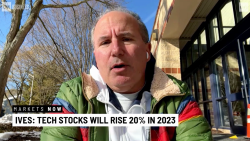The holiday season may be long over. But for those who may have done a bit too much shopping over the holidays, the financial hangover may still be lingering.
That may be especially true if you used your credit card to finance your holiday spending.
On average, American households carry around $6,300 in credit card debt, and pay an average interest rate of 14.65%, according to data from the Federal Reserve.
So if the bills are rolling in and you’re feeling a bit overwhelmed, know you’re not alone. Take these steps to tackle your holiday debt.
Take inventory of your spending
Your initial instinct may be to ignore your mounting credit card debt and put off paying down purchases. But facing your debt head-on is the first, most crucial step.
“It’s important to keep in mind that you can absolutely pay off this debt with intentional focus and by taking action,” said Bola Sokunbi, author, founder and CEO of Clever Girl Finance.
Start by getting clear on how much you’ve spent and what you owe on your credit cards. Doing this will allow you to devise a plan and a budget. It will also let you decide how you want to prioritize your debt, either by highest interest rate or smallest balance.
Once you’ve done this, you should have a full account of your spending and what expenses you can cut so you can maximize the amount you put toward paying off your debt each month.
Pick your debt strategy
You can employ two common strategies to tackle your debt: the “snowball” method and the “avalanche” method.
The snowball method involves arranging your card balances from smallest to largest. For the smallest balance, you’ll pay down as much you can, while making the minimum payments on all the others. Once you’ve paid that card off, you’ll move onto the next smallest debt. Repeat the process until you’ve paid down all your debt.
- Pros: This method helps you see progress more quickly and builds your enthusiasm and momentum toward paying off your debt.
- Cons: It can result in you paying more in interest over time if the cards with the larger balances also have higher interest rates.
The avalanche method involves paying off your debt by interest rate. Similar to the snowball method, you’ll arrange your debts, but this time, from highest to lowest interest rate. You’ll make minimum payments each month on all the cards and put any extra money toward the card with the highest interest balance. Repeat the process until you’re debt-free.
- Pros: By tackling higher interest rates firsts, this method helps you get out of debt more quickly and saves you more money over time.
- Cons: It can be a lot harder to stay motivated when you don’t see immediate results.
Avoid any spending on your credit cards while you’re paying them off. Doing this can lead to more debt and confusion on how much progress you’re actually making on paying it off.
Try a hybrid approach
For those interested in combining the two methods, Brian Walsh, senior manager of financial planning at SoFi, suggests an approach that combines the snowball and avalanche methods. It involves separating your debt into two buckets that include “good” and “bad” debt.
Walsh describes good debt as any debt with an interest rate of less than 7%, and bad debt as any debt with interest greater than 7%.
From there, you’ll pay the minimums on all your balances and take any extra money you have and put it toward the bad debt with the lowest balance. Once that’s paid off, you’ll add the amount you were paying to the bad debt with the next lowest balance. Repeat this process until all your bad debt is paid off.
“Once that happens, we believe you should focus on building an emergency fund, saving for retirement and investing for the future before aggressively paying down good debt,” he said.
Consider consolidating your debt
The snowball and avalanche method aren’t the only ways you can attack your debt. There are some other options, too.
Ted Rossman, an industry analyst for CreditCards.com, suggests that if you have good credit, consider consolidating your credit card debt with a lower-interest personal loan. You can also try a balance transfer card, which allows you to transfer your balance to a new credit card with a zero or low introductory interest rate.
However, Rossman notes, balance transfer cards have gotten hard to obtain during the pandemic.
“If you have a good credit score – I’ll say at least 700, although 720 or 740 would make you a stronger applicant – you might still be able to qualify. A year ago, 670 was a common threshold,” he said.
It’s important to keep in mind that balance transfer offers are only for a limited time. Many introductory rate periods can range between 12 to 24 months. However, if your balance isn’t paid off before that period ends, you could be stuck paying much higher interest on the remaining balance.
Some credit cards even charge deferred interest, meaning that for any balance remaining at the end of the introductory offer period, you are retroactively charged for all the interest you accrued since the beginning.
Another option is nonprofit credit counseling, in which counselors provide advice on how to consolidate your debt and negotiate lower rates. Rossman says these plans can last two to five years and carry interest rates in the 6% to 10% range.
The Federal Trade Commission advises choosing a credit counselor that offers a range of services, such as budget counseling, savings and debt management classes. Reputable agencies will usually send free information about themselves and the services they offer without you having to share details on your financial situation.
Similarly, you can reach out to your credit card issuer for a lower rate.
According to a survey from Bankrate, 78% of cardholders who tried this strategy were successful in receiving a lower rate.
“To improve your odds, cite competing offers that you received in the mail or saw online. It helps if you’re a good customer who has been with them a while and pays on time,” Rossman said.
Start planning now
Curious on how you can make sure you don’t rack up that post-holiday debt the next time around?
Sokunbi recommends a simple tip: plan ahead. Set up a designated savings account and put savings for the holidays as a line item in your budget.
“This will allow you to consistently save cash over time for the holiday season and help to avoid holiday debt.”






















